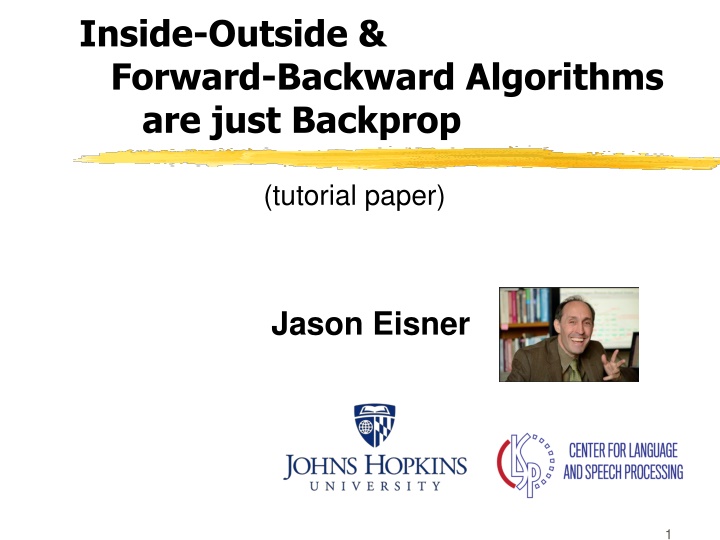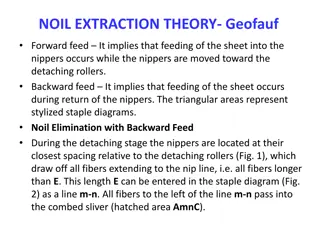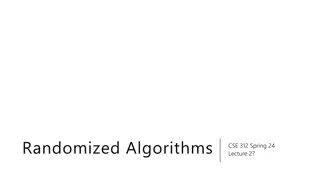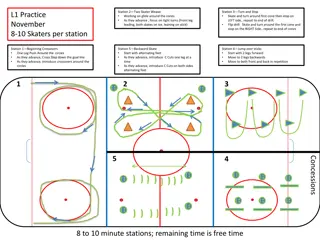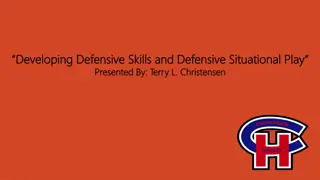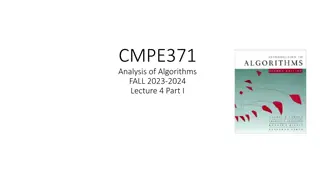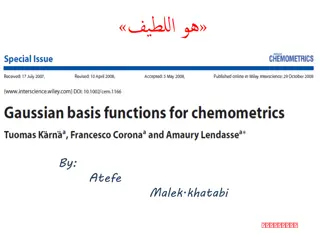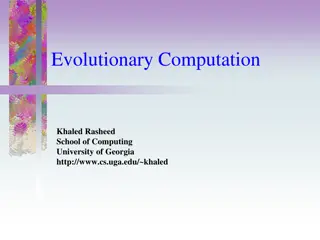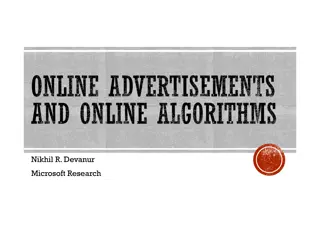Inside-Outside & Forward-Backward Algorithms by Jason Eisner
An exploration of the inside-outside and forward-backward algorithms by Jason Eisner, focusing on computing expected counts of substructures in parsing sentences. Delve into the complexities and applications of these algorithms through insightful visuals and explanations.
Download Presentation

Please find below an Image/Link to download the presentation.
The content on the website is provided AS IS for your information and personal use only. It may not be sold, licensed, or shared on other websites without obtaining consent from the author.If you encounter any issues during the download, it is possible that the publisher has removed the file from their server.
You are allowed to download the files provided on this website for personal or commercial use, subject to the condition that they are used lawfully. All files are the property of their respective owners.
The content on the website is provided AS IS for your information and personal use only. It may not be sold, licensed, or shared on other websites without obtaining consent from the author.
E N D
Presentation Transcript
Inside-Outside & Forward-Backward Algorithms are just Backprop (tutorial paper) Jason Eisner 1
The inside-outside algorithm is the hardest algorithm I know. a senior NLP researcher, in the 1990 s What does inside-outside do? It computes expected counts of substructures ... that appear in the true parse of some sentence w. 2
Where are the constituents? p=0.5 coal energy expert witness 3
Where are the constituents? p=0.1 coal energy expert witness 4
Where are the constituents? p=0.1 coal energy expert witness 5
Where are the constituents? p=0.1 coal energy expert witness 6
Where are the constituents? p=0.2 coal energy expert witness 7
Where are the constituents? coal energy expert witness 0.5+0.1+0.1+0.1+0.2 = 1 8
Where are NPs, VPs, ? NP locations VP locations S VP PP NP NP V P Det N Time Time flies flies like like an an arrow arrow 9
Where are NPs, VPs, ? NP locations VP locations Time flies like an arrow Time flies like an arrow (S (NP Time) (VP flies (PP like (NP an arrow)))) p=0.5 10
Where are NPs, VPs, ? NP locations VP locations Time flies like an arrow Time flies like an arrow (S (NP Time flies) (VP like (NP an arrow))) p=0.3 11
Where are NPs, VPs, ? NP locations VP locations Time flies like an arrow Time flies like an arrow (S (VP Time (NP (NP flies) (PP like (NP an arrow))))) p=0.1 12
Where are NPs, VPs, ? NP locations VP locations Time flies like an arrow Time flies like an arrow (S (VP (VP Time (NP flies)) (PP like (NP an arrow)))) p=0.1 13
Where are NPs, VPs, ? NP locations VP locations Time flies like an arrow Time flies like an arrow 0.5+0.3+0.1+0.1 = 1 14
How many NPs, VPs, in all? NP locations VP locations Time flies like an arrow Time flies like an arrow 0.5+0.3+0.1+0.1 = 1 15
How many NPs, VPs, in all? NP locations VP locations Time flies 2.1 NPs (expected) like an arrow Time flies 1.1 VPs (expected) like an arrow 16
Where did the rules apply? S NP VP locations NP Det N locations Time flies like an arrow Time flies like an arrow 17
Where did the rules apply? S NP VP locations NP Det N locations Time flies like an arrow Time flies like an arrow (S (NP Time) (VP flies (PP like (NP an arrow)))) p=0.5 18
Where is S NP VP substructure? S NP VP locations NP Det N locations Time flies like an arrow Time flies like an arrow (S (NP Time flies) (VP like (NP an arrow))) p=0.3 19
Where is S NP VP substructure? S NP VP locations NP Det N locations Time flies like an arrow Time flies like an arrow (S (VP Time (NP (NP flies) (PP like (NP an arrow))))) p=0.1 20
Where is S NP VP substructure? S NP VP locations NP Det N locations Time flies like an arrow Time flies like an arrow (S (VP (VP Time (NP flies)) (PP like (NP an arrow)))) p=0.1 21
Why do we want this info? Grammar reestimation by EM method E step collects those expected counts M step sets Minimum Bayes Risk decoding Find a tree that maximizes expected reward, e.g., expected total # of correct constituents CKY-like dynamic programming algorithm The input specifies the probability of correctness for each possible constituent (e.g., VP from 1 to 5) 22
Why do we want this info? Soft features of a sentence for other tasks NER system asks: Is there an NP from 0 to 2? True answer is 1 (true) or 0 (false) But we return 0.3, averaging over all parses That s a perfectly good feature value can be fed as to a CRF or a neural network as an input feature Writing tutor system asks: How many times did the student use S NP[singular] VP[plural]? True answer is in {0, 1, 2, } But we return 1.8, averaging over all parses 23
How do we compute it all? How I usually teach it: CKY recognizer add weights inside algorithm develop an analogy to forward-backward inside-outside algorithm But algorithm is confusing, and I wave my hands instead of giving a real proof 24
Inside & Outside Probabilities S NP time VP VP(1,5) = p(time VP today | S) VP NP today PP V VP(1,5) = p(flies like an arrow | VP) flies P NP like VP(1,5) * VP(1,5) = p(time [VP flies like an arrow] today | S) Det an N arrow 600.465 - Intro to NLP - J. Eisner 25
Inside & Outside Probabilities S NP time VP VP(1,5) = p(time VP today | S) VP NP today PP V VP(1,5) = p(flies like an arrow | VP) flies P NP like / S(0,6) VP(1,5) * VP(1,5) = p(time flies like an arrow today & VP(1,5) | S) p(time flies like an arrow today | S) Det an N arrow = p(VP(1,5) | time flies like an arrow today, S) 600.465 - Intro to NLP - J. Eisner 26
Inside & Outside Probabilities S NP time VP VP(1,5) = p(time VP today | S) VP NP today PP V VP(1,5) = p(flies like an arrow | VP) flies P NP like analogous Det an N arrow to forward-backward in the finite-state case! So VP(1,5) * VP(1,5) / s(0,6) is probability that there is a VP here, given all of the observed data (words) C C C Start H H H 600.465 - Intro to NLP - J. Eisner 27
How do we compute it all? How I usually teach it: CKY recognizer add weights inside algorithm This step for free as backprop! develop an analogy to forward-backward inside-outside algorithm But algorithm is confusing, and I wave my hands instead of giving a real proof 28
Back-Propagation arithmetic circuit (computation graph) 29
Energy-Based Models Define Then Log-linear case: 30
p(tree T | sentence w) is log-linear total prob of all parses Therefore, log Z will give expected rule counts. 31
log Z = Expected Counts Optimization Gradient Expected counts novel alg. 32
log Z = Expected Counts Optimization (EM) & MBR decoding & soft features Expected counts Gradient Not only does this get the same answer, it actually gives the identical algorithm! backprop 33
Terminology Automatic differentiation: Given a circuit that computes a function f, construct a circuit to compute (f, f) 34
Terminology Automatic differentiation: Given a circuit that computes a function f, construct a circuit to compute (f, f) Algorithmic differentiation: Given code that computes a function f, construct code to compute (f, f) Back-propagation: One computational strategy that the new circuit or code can use 35
Inside algorithm computes Z Essentially creates a circuit on the fly Like other dynamic programming algorithms Circuit structure gives parse forest hypergraph O(Vn2) nodes in the circuit, with names like (VP,1,5) Each node sums O(V2n) 3-way products The 3-way products and the intermediate sums aren t nodes of the formal circuit No names, not stored long-term 36
Inside algorithm computes Z visit nodes bottom-up (toposort) 37
How to differentiate ( swap x, y1) ( swap x, y2) 38
Inside algorithm has 3-way products (A += G*B*C) (swap A, G) (swap A, B) (swap A, C) 39
Inside algorithm has 3-way products [ ] is traditionally called [ ] We ll similarly write G[A B C] as [A B C] 40
Differentiate to compute (Z, Z) visit nodes in reverse order of (so top-down) wait, what s this line? 41
The final step: / Z we want this but oops, we used backprop to get this, so fix it could reasonably rename G(R) to (R) 42
The final step: / Z This final step is annoying. It s more chain rule. Shouldn t that be part of backprop? We won t need it if we actually compute log Z in the first place (straightforwardly). We only did Z for pedagogical reasons. It s closer to the original inside-outside algorithm, and ensures = traditional . But the straightforward way is slightly more efficient. 43
Inside algorithm has 3-way products [ ] is traditionally called [ ] Paper spells out why the traditional outer weight interpretation of is actually a partial derivative 44
Other algorithms! E.g.: Formalism How to compute Z (total weight of all derivations) Expected counts of substructures = log Z backprop backprop backprop backprop backprop backprop backprop backprop backprop backprop backprop HMM PCFG in CNF CRF-CFG in CNF semi-Markov CRF arbitrary PCFG CCG TAG dependency grammar transition-based parsing synchronous grammar graphical model backward algorithm inside algorithm inside algorithm Saragawi & Cohen 2004 Earley s algorithm Vijay-Shankar & Weir 1990 Vijay-Shankar & Joshi 1987 Eisner & Satta PDA with graph-structured stack synchronous inside algorithm junction tree 45
Other tips in the paper An inside-outside algorithm should only be a few times as slow as its inside algorithm. People sometimes publish algorithms that are n times slower. This is a good reason to formally go through algorithmic differentiation. 46
Other tips in the paper An inside-outside algorithm should only be a few times as slow as its inside algorithm. HMMs can be treated as a special case of PCFGs. 47
Other tips in the paper An inside-outside algorithm should only be a few times as slow as its inside algorithm. HMMs can be treated as a special case of PCFGs. There are 2 other nice derivations of inside-outside. All yield essentially the same code, and the other perspectives are useful too. The Viterbi variant is useful for pruning (max-marginal counts) and parsing (Viterbi outside scores). It can be obtained as the 0-temperature limit of the gradient- based algorithm. The gradient view makes it easy to do end-to-end training if the parser talks to / listens to neural nets. 48
